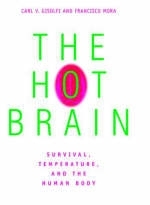
The Hot Brain
Survival, Temperature and the Human Body
Seiten
2000
Bradford Books (Verlag)
978-0-262-07198-7 (ISBN)
Bradford Books (Verlag)
978-0-262-07198-7 (ISBN)
- Titel ist leider vergriffen;
keine Neuauflage - Artikel merken
The book traces the story of the brain throughout evolution and shows how the control of body temperature as a survival mechanism was achieved.
From the first unicellular life on Earth, living things have had the capacity to sense heat and cold and to avoid extreme temperatures. With the development of a bigger brain and a constant body temperature, mammals were able to change their habitats. The interplay between behavior, body temperature, and ambient temperature may have played a crucial role in human evolution. In this book Carl Gisolfi and Francisco Mora tell the evolutionary story of the brain and thermoregulation, with an emphasis on modern humans. The book first traces the story of the brain throughout evolution and shows how the control of body temperature as a survival mechanism was achieved. It then goes on to discuss the mechanisms of our environmental independence, why a body temperature of 37- C (only five degrees from death) is essential for humans and how this narrow temperature range is defended. It describes how we cope with environmental extremes, the function of fevers, and why thermoregulation is best understood through a combination of physiological and cognitive approaches. It also addresses such questions as "Can we cool the brain?" and "Is the elevation in brain temperature (a hot brain) the reason we stop exercising?"
From the first unicellular life on Earth, living things have had the capacity to sense heat and cold and to avoid extreme temperatures. With the development of a bigger brain and a constant body temperature, mammals were able to change their habitats. The interplay between behavior, body temperature, and ambient temperature may have played a crucial role in human evolution. In this book Carl Gisolfi and Francisco Mora tell the evolutionary story of the brain and thermoregulation, with an emphasis on modern humans. The book first traces the story of the brain throughout evolution and shows how the control of body temperature as a survival mechanism was achieved. It then goes on to discuss the mechanisms of our environmental independence, why a body temperature of 37- C (only five degrees from death) is essential for humans and how this narrow temperature range is defended. It describes how we cope with environmental extremes, the function of fevers, and why thermoregulation is best understood through a combination of physiological and cognitive approaches. It also addresses such questions as "Can we cool the brain?" and "Is the elevation in brain temperature (a hot brain) the reason we stop exercising?"
| Erscheint lt. Verlag | 29.6.2000 |
|---|---|
| Reihe/Serie | Bradford Books |
| Zusatzinfo | 94 |
| Verlagsort | Massachusetts |
| Sprache | englisch |
| Maße | 160 x 231 mm |
| Gewicht | 590 g |
| Themenwelt | Geisteswissenschaften ► Psychologie ► Biopsychologie / Neurowissenschaften |
| Studium ► 1. Studienabschnitt (Vorklinik) ► Physiologie | |
| Naturwissenschaften ► Biologie ► Humanbiologie | |
| Naturwissenschaften ► Biologie ► Zoologie | |
| ISBN-10 | 0-262-07198-3 / 0262071983 |
| ISBN-13 | 978-0-262-07198-7 / 9780262071987 |
| Zustand | Neuware |
| Haben Sie eine Frage zum Produkt? |
Mehr entdecken
aus dem Bereich
aus dem Bereich


